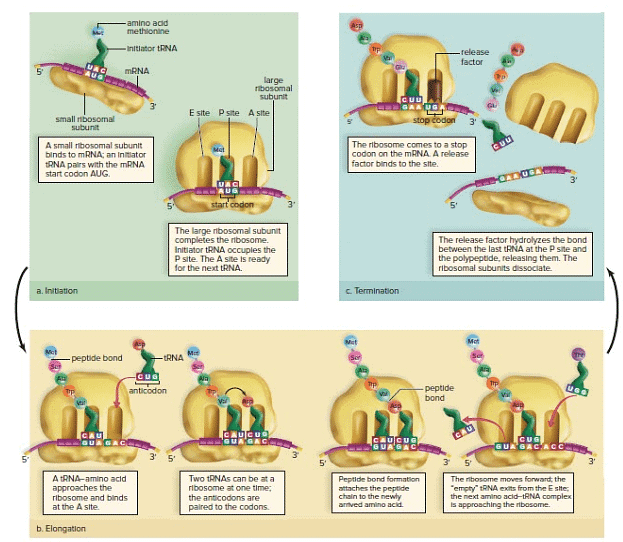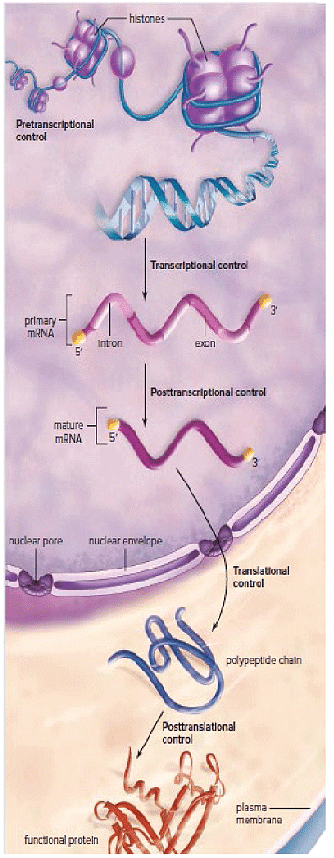UPSC Exam > UPSC Notes > Zoology Optional Notes for UPSC > Gene Expression
Gene Expression | Zoology Optional Notes for UPSC PDF Download
Objectives
Understand the Structure and Functions of Proteins
- Proteins act as a blueprint for synthesizing proteins.
- DNA serves as a template for RNA, which, in turn, serves as a template for protein synthesis.
Know the Process of Gene Expression
- Gene expression involves the conversion of a gene's coded information into the structures present and operating in the cell.
- It encompasses two steps: transcription and translation.
Describe the Process of Transcription
- Transcription is the first step in gene expression.
- During transcription, a complementary mRNA strand is formed based on the template strand of the DNA molecule.
- The sequence of nucleotides in DNA is faithfully copied to a complementary sequence in mRNA.
Describe the Process of Translation
- Translation is the second step in gene expression.
- A sequence of nucleotides in mRNA is translated into the sequence of amino acids in a protein.
Understand How Gene Expression may be Regulated by a Cell
- The regulation of gene expression is crucial for controlling cellular functions.
Structure and Function of Proteins
Proteins and Polypeptides
- Proteins are formed of polypeptides, composed of amino acid subunits.
- There are 20 different amino acids in most proteins.
- Protein diversity arises from the number and order of amino acids, determining the protein's shape.
Functions of Proteins
- Proteins serve various functions:
- Structural and regulatory components of cells.
- Enzymes catalyze chemical reactions.
- Neurotransmitters aid in the nervous system.
- Antibodies function in the immune system.
- Hormones change activities of certain cells.
Gene Expression: An Overview
Gene
- The fundamental unit of heredity.
- An ordered sequence of nucleotides on a chromosome that encodes a specific functional product (protein or RNA).
- The process converting a gene's coded information into cellular structures.
- Involves transcription and translation.
- Expressed genes include those transcribed into mRNA and translated into protein, as well as those transcribed into RNA without translation.
The Genetic Code
Genetic Code
- A sequence of nucleotides coded in triplets (codons) along mRNA, determining amino acid sequence.
- DNA sequence predicts mRNA, and genetic code predicts amino acid sequence.

Codon Structure
- Codons consist of three bases, providing 64 possible combinations.
- Redundancy in the genetic code protects against harmful mutations.
- Stop codons signal polypeptide termination.
Methionine and Start Codon
- AUG codes for methionine, signaling the beginning of the polypeptide.
Transcription
Transcription Process
- RNA polymerase and transcription factors join the DNA at the promoter.
- DNA double helix opens, allowing complementary base pairing.
- RNA polymerase joins RNA nucleotides, forming a complementary mRNA strand.
- Transcription ends at the terminator, and the mRNA separates from DNA.
- RNA polymerase initiates transcription of a new RNA strand.
mRNA Formation
- Transcription commences in the nucleus as RNA polymerase and associated transcription factors bind to the DNA double helix at a specific DNA sequence known as the promoter (found at the start site, e.g., TATA box & CAAT box).

- Subsequently, RNA polymerase opens the DNA double helix, facilitating complementary base pairing.
- RNA polymerase then connects RNA nucleotides to the 3' end of the RNA chain, resulting in an mRNA molecule with a base sequence complementary to the DNA segment. (Note: RNA, containing uracil instead of thymine, forms base pairs with adenine and cytosine in DNA, following A-U and C-G pairing).
- Transcription concludes when RNA polymerase reaches a designated DNA sequence called the terminator (stop site). At this point, the formed RNA molecule separates from DNA. Following this, RNA polymerase initiates the transcription of a new RNA strand, continuing the process.

Processing mRNA
Overview
- Transcribed mRNA undergoes processing before leaving the nucleus for translation in the cytoplasm.
- Processing transforms the primary mRNA molecule into a mature mRNA molecule.
Introns and Exons
- Genes in humans often contain introns (non-coding segments) and exons (coding segments).
- Introns do not code for functional proteins, while exons express and code for functional proteins.
Steps of RNA Processing
5' Capping
- Modification of the newly formed mRNA involves adding a methylated guanine nucleotide to the 5' end, forming the 5' cap.
- The 5' cap facilitates mRNA transport to the cytoplasm, attachment to ribosomes, and protects against degradation.
Polyadenylation
- Cleavage of the 3' end involves adding approximately 200 adenosine residues, creating the poly (A) tail.
- The poly (A) tail facilitates mRNA transport to the cytoplasm and translation.
mRNA Splicing
- Introns are removed, and exons join to form a mature mRNA molecule.
- Splicing is carried out by a spliceosome, a complex of RNA and protein.
- Alternate mRNA splicing can result in different mature RNA transcripts from a single gene, contributing to protein diversity.
Small RNA Molecules
- Small RNA molecules regulate mRNA processing, transcription, and translation.
- RNA plays a pivotal role in orchestrating cellular outcomes.
Translation

Process Overview
- Translation is the process by which mRNA codes for protein synthesis at ribosomes.
Ribosome Structure
- The ribosome contains binding sites (A, P, and E) where tRNA molecules bind with the mRNA strand.
tRNA Structure
- tRNA molecules have a cloverleaf shape with areas for binding amino acids and anticodons.
- The anticodon, a three-base sequence, pairs with mRNA codons via complementary base pairing.
Translation Process
1. Initiation
- mRNA binds to the smaller ribosomal subunit, and the larger subunit associates, forming the translation complex.
2. Elongation
- Polypeptide lengthens as tRNA molecules bring amino acids to the ribosome.
- Ribosome moves down mRNA, adding amino acids one at a time.
- Termination occurs when a stop codon enters the A site, requiring a release factor to cleave the polypeptide from the last tRNA.
3. Termination
- Release factor binds to stop codon, cleaving the polypeptide from the last tRNA.
- Ribosome dissociates into two subunits and falls off mRNA.
- Multiple ribosomes, forming a polyribosome, can work on one mRNA simultaneously, increasing protein synthesis efficiency.

The Regulation of Gene Expression
Overview
- All cells possess copies of all genes, but actively expressed genes differ among cells.
- Mechanisms regulating gene expression occur at various stages: pretranscriptional, transcriptional, posttranscriptional, translational, and posttranslational.
Pretranscriptional Control (In the Nucleus)
- DNA accessibility to transcription enzymes is crucial.
- Chromosome decondensation or uncoiling is necessary.
- Removal of proteins and chemical modifications protecting DNA precedes transcription.
Transcriptional Control (In the Nucleus)
- Mechanisms determine which genes are transcribed and the transcription rate.
- Transcription factors, influenced by environmental and genetic factors, initiate transcription.
- Control through signaling molecules, intracellular receptors, and cell surface receptors.
- Transcription factors bind to specific DNA promoter elements, activating RNA polymerase.
- Enhancers increase transcriptional activity, interacting with activators, while silencers inhibit transcription, interacting with repressors.

Translational Control (In the Cytoplasm)
- Occurs after mRNA leaves the nucleus but before protein synthesis.
- Some mRNAs require additional changes affecting mRNA life expectancy and ribosome binding.
- microRNAs (miRNAs) inhibit translation, while small interfering RNAs (siRNA) mark mRNA for destruction by nucleases.
Posttranslational Control (In the Cytoplasm)
- Occurs after protein synthesis.
- Polypeptide products may undergo additional changes before becoming biologically functional.
- Feedback control: Binding of a product can alter the enzyme's shape, affecting its function.
Transcription Factors
Overview
- Transcription factors in human cells are non-histone DNA-binding proteins.
- They act as fine-tuners, controlling gene expression levels like variable light switches.
- Cells contain various types of transcription factors that, in combination, regulate transcription.
- Differentiation and specialization of cells depend on the activity of specific transcription factors.
Example
- Cells receive signals that turn genes on or off, influencing transcription factors.
- Embryonic hand development illustrates how apoptosis (programmed cell death) gene activation shapes the formation of fingers.
RNA-Directed DNA Synthesis
Central Dogma
- Initially, genetic information was believed to flow from DNA to RNA to protein (central dogma).
RNA-Directed DNA Synthesis
- Retroviruses provide evidence of occasional genetic information flow from RNA to DNA.
- Reverse transcriptase enzyme facilitates this RNA-directed DNA synthesis.
- DNA regions in normal cells may serve as templates for RNA synthesis, which, in turn, acts as a template for DNA synthesis.
- Homology between human and retroviral oncogene sequences suggests therapeutic potential for treating inherited diseases.

The document Gene Expression | Zoology Optional Notes for UPSC is a part of the UPSC Course Zoology Optional Notes for UPSC.
All you need of UPSC at this link: UPSC
|
181 videos|346 docs
|
FAQs on Gene Expression - Zoology Optional Notes for UPSC
| 1. What is the structure of proteins? |  |
Ans. Proteins are large, complex molecules made up of amino acids. They have a unique three-dimensional structure that determines their function. Proteins can have primary, secondary, tertiary, and quaternary structures.
| 2. How do proteins carry out their functions in the body? |  |
Ans. Proteins perform various functions in the body, such as acting as enzymes to catalyze biochemical reactions, serving as structural components of cells and tissues, transporting molecules across membranes, and regulating gene expression.
| 3. What is gene expression and how does it work? |  |
Ans. Gene expression refers to the process by which information from a gene is used to synthesize a functional gene product, such as a protein. It involves two main steps: transcription, where the DNA sequence is copied into messenger RNA (mRNA), and translation, where the mRNA is used as a template to synthesize a protein.
| 4. What is the genetic code? |  |
Ans. The genetic code is a set of rules that determines how the nucleotide sequence of a gene is translated into the amino acid sequence of a protein. It is a universal code, meaning that the same codons (three-nucleotide sequences) specify the same amino acids in all organisms.
| 5. How is gene expression regulated? |  |
Ans. Gene expression is regulated at various levels to ensure that the right genes are expressed in the right cells at the right time. Transcription factors play a key role in regulating gene expression by binding to specific DNA sequences and either activating or repressing transcription. Other regulatory mechanisms include epigenetic modifications, alternative splicing, and post-translational modifications of proteins.

|
Explore Courses for UPSC exam
|

|
Signup for Free!
Signup to see your scores go up within 7 days! Learn & Practice with 1000+ FREE Notes, Videos & Tests.
Related Searches

























